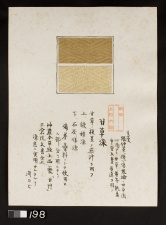Difference between revisions of "Kanzou - bottom (198 B)"
Jump to navigation
Jump to search
(username removed) |
(username removed) |
||
| (One intermediate revision by the same user not shown) | |||
| Line 5: | Line 5: | ||
| 198 | | 198 | ||
|- | |- | ||
| − | ! scope="row"| | + | ! scope="row"|Uemura number / title |
| − | | | + | | ; "Haze-some 25" |
|- | |- | ||
! scope="row"|Folder location | ! scope="row"|Folder location | ||
| Line 38: | Line 38: | ||
| - | | - | ||
|- | |- | ||
| − | ! scope="row"| | + | ! scope="row"|Uemura's notes |
| − | | The plant had been used as medicine, but not as dyestuff. For this dyeing, the plant prepared for medicine was used. The plant was listed as medicinal plants in historic manuscripts, including the | + | | The plant had been used as medicine, but not as dyestuff. For this dyeing, the plant prepared for medicine was used. The plant was listed as medicinal plants in historic manuscripts, including the Shos-in monjyo () from the 8th century AD, Japan, and the Shinnhonzoukyo () from 300 BC - 200 AD, China. |
|- | |- | ||
| − | ! scope="row"| | + | ! scope="row"|Uemura's date |
| Kyoto | | Kyoto | ||
|} | |} | ||
| − | [[Category: | + | [[Category:Uemura dye archive]] |
Latest revision as of 06:18, 24 July 2013
| Museum number | 198 |
|---|---|
| Uemura number / title | ; "Haze-some 25" |
| Folder location | 3rd shelf |
| Sample location | bottom (198 B) |
| Fiber type | silk |
| Color | cream (slightly blue tone) |
| Dyestuff (Japanese common name) | 甘草 : Kanzou |
| Plant part | root & stem / dried (?) |
| Dyestuff extraction | boiled in water |
| Auxiliary agent in dye bath | - |
| Mordant | lime water |
| Other auxiliary agent | - |
| Uemura's notes | The plant had been used as medicine, but not as dyestuff. For this dyeing, the plant prepared for medicine was used. The plant was listed as medicinal plants in historic manuscripts, including the Shos-in monjyo () from the 8th century AD, Japan, and the Shinnhonzoukyo () from 300 BC - 200 AD, China. |
| Uemura's date | Kyoto |
